
Answer
457.2k+ views
Hint: As we know that acetylene contains two hydrogen and two carbon in which carbon is attached with another carbon with triple bond if sodium is attached with acetylene then it will act as a nucleophile.
Complete step by step answer:
The mono sodium acetylide is prepared by sodium hydroxide (a strong base). When acetylene reacts with sodium hydroxide, this abstracts the hydrogen from acetylene because the acetylene proton is acidic due to \[sp\] hybridization of carbon thus, water eliminates and we get mono sodium acetylide which is represented as \[CH \equiv {C^ - }N{a^ + }\].
Now \[CH \equiv {C^ - }N{a^ + }\] contains a dipolar group (ylide) and acts as a nucleophile so it reacts with alkyl halide by \[S{N^2}\] (nucleophilic substitution reaction) process. The alkyl halide contains a halogen element which is a good leaving group that can easily leave when\[CH \equiv {C^ - }N{a^ + }\] attacks on it.
As we can see in the mechanism-

Therefore, the alkyl group is attached with the nucleophilic carbon by eliminating sodium halide.
Now the product is formed which contains an alkyne group and alkyl group so the correct option is option (C).
Note:
The symmetrical higher alkyne can also be prepared with the above mechanism but we have to take two equivalents of sodium hydroxide.
Complete step by step answer:
The mono sodium acetylide is prepared by sodium hydroxide (a strong base). When acetylene reacts with sodium hydroxide, this abstracts the hydrogen from acetylene because the acetylene proton is acidic due to \[sp\] hybridization of carbon thus, water eliminates and we get mono sodium acetylide which is represented as \[CH \equiv {C^ - }N{a^ + }\].
Now \[CH \equiv {C^ - }N{a^ + }\] contains a dipolar group (ylide) and acts as a nucleophile so it reacts with alkyl halide by \[S{N^2}\] (nucleophilic substitution reaction) process. The alkyl halide contains a halogen element which is a good leaving group that can easily leave when\[CH \equiv {C^ - }N{a^ + }\] attacks on it.
As we can see in the mechanism-

Therefore, the alkyl group is attached with the nucleophilic carbon by eliminating sodium halide.
Now the product is formed which contains an alkyne group and alkyl group so the correct option is option (C).
Note:
The symmetrical higher alkyne can also be prepared with the above mechanism but we have to take two equivalents of sodium hydroxide.
Recently Updated Pages
Identify the feminine gender noun from the given sentence class 10 english CBSE

Your club organized a blood donation camp in your city class 10 english CBSE

Choose the correct meaning of the idiomphrase from class 10 english CBSE

Identify the neuter gender noun from the given sentence class 10 english CBSE

Choose the word which best expresses the meaning of class 10 english CBSE

Choose the word which is closest to the opposite in class 10 english CBSE

Trending doubts
Fill the blanks with the suitable prepositions 1 The class 9 english CBSE

Which are the Top 10 Largest Countries of the World?

Change the following sentences into negative and interrogative class 10 english CBSE

Difference between Prokaryotic cell and Eukaryotic class 11 biology CBSE

10 examples of friction in our daily life

How do you graph the function fx 4x class 9 maths CBSE

Give 10 examples for herbs , shrubs , climbers , creepers

The Equation xxx + 2 is Satisfied when x is Equal to Class 10 Maths

What is pollution? How many types of pollution? Define it




